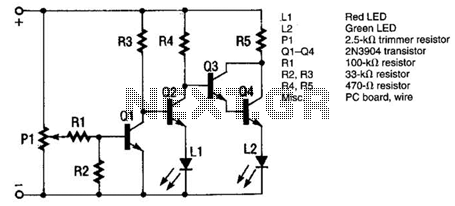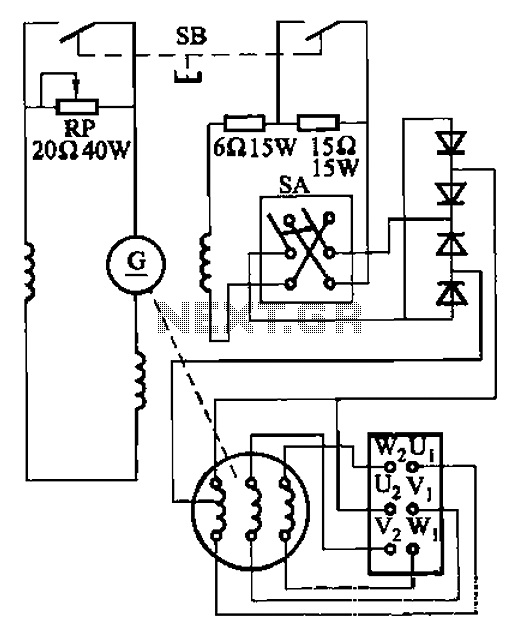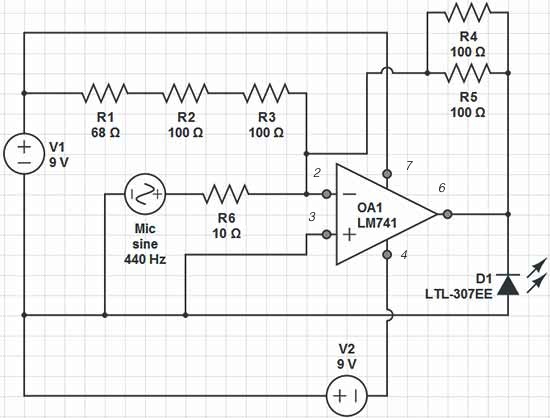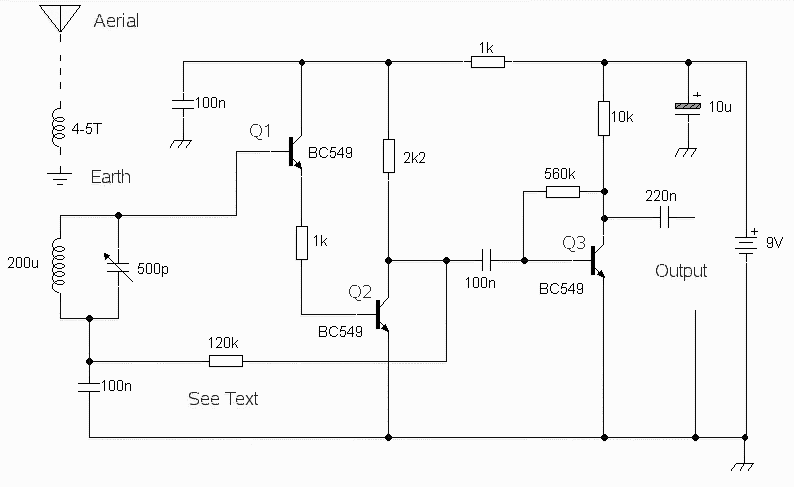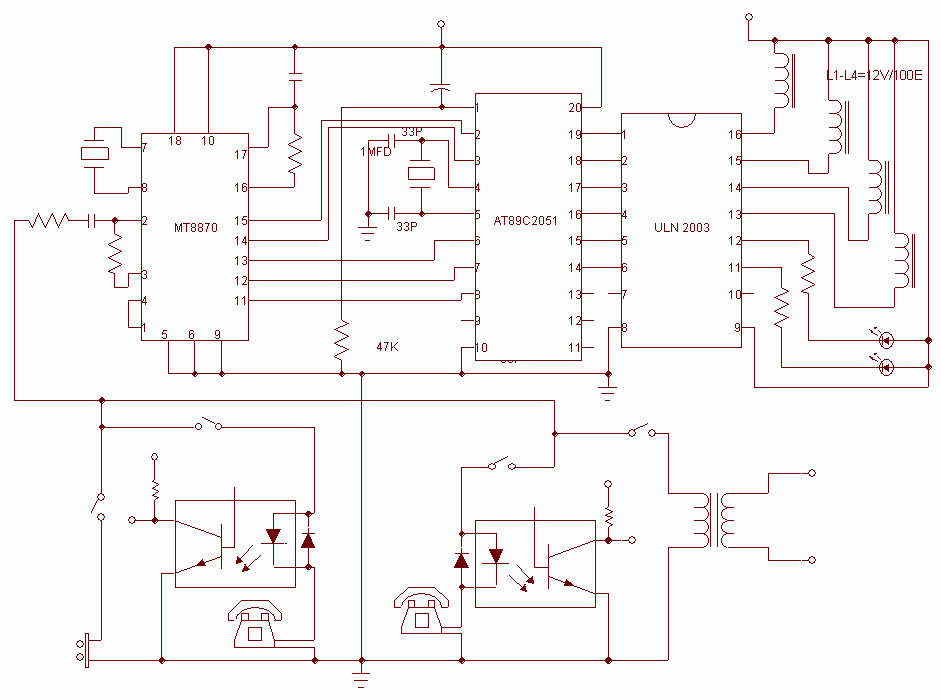
Opamp VHF FM Transmitter circuit
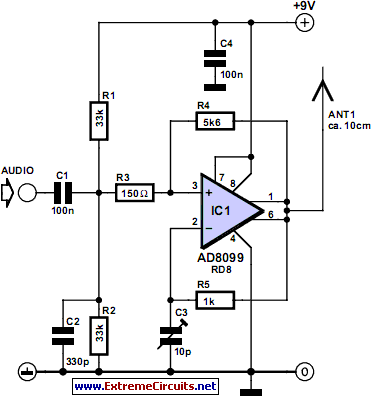
This operational amplifier (opamp) is available at a low cost. The AD8099 is a very fast opamp with a slew rate of 1600 V/µs and features high-impedance inputs with low input capacitance. Its bandwidth is sufficiently large that at 100 MHz, it still maintains a gain of nearly 40. This characteristic allows the opamp to be utilized in creating an RC oscillator. The presented circuit exhibits several notable features. Firstly, unlike conventional oscillators that utilize transistors, this design does not incorporate any inductors. Secondly, there is no requirement for a varicap diode for frequency modulation. The opamp is configured as a Schmitt trigger with minimal hysteresis. The output is fed back through an RC circuit, which results in the continuous charging and discharging of the trimmer capacitor whenever the voltage reaches the hysteresis threshold. Consequently, the output toggles continuously, producing a square wave output voltage. With a 10-pF trimmer capacitor, the frequency can be adjusted within the VHF FM broadcast band (88-108 MHz), and the oscillator frequency remains stable for this purpose. The output voltage is approximately 6 Vpp at a power supply voltage of 9 V, with a transmitter power of around 50 mW at a 50Ω load. This output power is significantly higher than that of an average transistor-based oscillator. Using a short antenna of about 10 cm, the circuit can function effectively as a test transmitter within a home environment. However, due to the presence of harmonics in the output signal, the use of an outdoor antenna is not advisable without an additional filter or adapter, such as a pi-filter. FM modulation is accomplished by varying the hysteresis, which in turn affects the oscillator frequency. An audio signal of approximately 20 mVpp is adequate for achieving a reasonable output amplitude. The opamp package is an 8-pin SOIC (specifically the version with the RD8 suffix), with a pin spacing of 1/20 inch (1.27 mm), making it feasible to solder with appropriate tools. If surface-mount devices (SMD) are employed for the other components, the circuit can be compactly designed. A single transistor can be incorporated into the circuit to serve as a microphone amplifier if needed. The power supply voltage should not exceed 12 V, as the IC is not rated for higher voltages. The current consumption at 9 V is only 15 mA. As with all free-running oscillator circuits, the output frequency is sensitive to fluctuations in power supply voltage, necessitating the use of a voltage regulator for optimal stability. Additionally, the circuit can be adapted for use as a voltage-controlled oscillator (VCO) in applications such as phase-locked loops (PLLs) by substituting the trimmer capacitor with a varicap diode, thus expanding the frequency range beyond that of an LC oscillator. This is due to the fact that the tuning range of an LC oscillator is proportional to the square root of the capacitance ratio, whereas an RC oscillator's range corresponds directly to the entire capacitance ratio. For example, with a capacitance ratio of 1:9, an LC oscillator can be tuned over a range of 1:3, while an RC oscillator can achieve a range of 1:9. Furthermore, the circuit has sufficient output power to directly drive a diode mixer, such as an SBL-1, which typically requires a local oscillator signal with power between 5 to 10 mW. Given that this oscillator can deliver up to 50 mW, a simple attenuator using a couple of resistors is adequate for interfacing the two components.This opamp is available for only a few pounds. The AD8099 is a very fast opamp (1600 V/ms) and has high-impedance inputs with low input capacitance. The bandwidth of the opamp is so largethat at 100 MHz it still has a gain of nearly 40. This means that this opamp can be used to create an RC oscillator. The circuit presented here realises that. The circuit has a few striking vcharacteristics. Firstly, unlike normal oscillators that contain transistors this one does not have any inductors. Secondly, there is no need for a varicap diode to do the FM modulation. The opamp is configured as a Schmitt trigger with only a small amount of hysteresis. The output is fed back via an RC circuit. In this way, the trimmer capacitor is continually being charged and discharged when the voltage reaches the hysteresis threshold.
The output continually toggles as a consequence. This results in a square wave output voltage. With a 10-pF trimmer capacitor the frequency can be adjusted into the VHF FM broadcast band 88-108 MHz). The frequency of the oscillator is stable enough for this. The output voltage is about 6 Vpp at a power supply voltage of 9 V. The transmitter power amounts to about 50 mW at a load of 50R. This is about 20 times as much as the average oscillator with a transistor. With a short antenna of about 10 cm, the range is more than sufficient to use the circuit in the home as a test transmitter.
Because the output signal is not free from harmonics the use of an outdoor antenna is not recommended. This requires an additional filter/adapter at the output (you could use a pi-filter for this). The FM modulation is achieved by modulating the hysteresis, which influences the oscillator frequency.
An audio signal of about 20 mVpp is sufficient for a reasonable output amplitude. The package for the opamp is an 8-pin SOIC (provided you use the version with he RD8 suffix). The distance between the pins on this package is 1/20 inch 1. 27 mm). This is still quite easy to solder with descent tools. If SMD parts are used for the other components as well then the circuit can be made very small. If necessary, a single transistor can be added to the circuit to act as microphone amplifier. The power supply voltage may not be higher than 12 V, because the IC cannot withstand that. The current consumption at 9 V is only 15 mA. As with all free-running oscillator circuits, the output frequency of this specimen is also sensitive to variations of the power supply voltage. For optimum stability, a power supply voltage regulator is essential. As an additional design tip for this circuit, we show an application as VCO for, for example, a PLL circuit.
When the trimmer capacitor is replaced with a varicap diode, the frequency range can be greater than that of an LC oscillator. That`s because with an LC-oscillator the range is proportional to the square root of the capacitance ratio.
With an RC oscillator the range is equal to the entire capacitance ratio. For example: with a capacitance ratio of 1:9, an LC oscillator can be tuned over a range of 1:3. With an RC oscillator this is 1:9. For the second tip, we note that the circuit can provide sufficient power to drive a diode mixer (such as a SBL-1) directly. This type of mixer requires a local oscillator signal with a power from 5 to 10 mW and as already noted, this oscillator can deliver 50 mW.
A simple attenuator with a couple of resistors is sufficient in this case to adapt the two to each other. 🔗 External reference
The output continually toggles as a consequence. This results in a square wave output voltage. With a 10-pF trimmer capacitor the frequency can be adjusted into the VHF FM broadcast band 88-108 MHz). The frequency of the oscillator is stable enough for this. The output voltage is about 6 Vpp at a power supply voltage of 9 V. The transmitter power amounts to about 50 mW at a load of 50R. This is about 20 times as much as the average oscillator with a transistor. With a short antenna of about 10 cm, the range is more than sufficient to use the circuit in the home as a test transmitter.
Because the output signal is not free from harmonics the use of an outdoor antenna is not recommended. This requires an additional filter/adapter at the output (you could use a pi-filter for this). The FM modulation is achieved by modulating the hysteresis, which influences the oscillator frequency.
An audio signal of about 20 mVpp is sufficient for a reasonable output amplitude. The package for the opamp is an 8-pin SOIC (provided you use the version with he RD8 suffix). The distance between the pins on this package is 1/20 inch 1. 27 mm). This is still quite easy to solder with descent tools. If SMD parts are used for the other components as well then the circuit can be made very small. If necessary, a single transistor can be added to the circuit to act as microphone amplifier. The power supply voltage may not be higher than 12 V, because the IC cannot withstand that. The current consumption at 9 V is only 15 mA. As with all free-running oscillator circuits, the output frequency of this specimen is also sensitive to variations of the power supply voltage. For optimum stability, a power supply voltage regulator is essential. As an additional design tip for this circuit, we show an application as VCO for, for example, a PLL circuit.
When the trimmer capacitor is replaced with a varicap diode, the frequency range can be greater than that of an LC oscillator. That`s because with an LC-oscillator the range is proportional to the square root of the capacitance ratio.
With an RC oscillator the range is equal to the entire capacitance ratio. For example: with a capacitance ratio of 1:9, an LC oscillator can be tuned over a range of 1:3. With an RC oscillator this is 1:9. For the second tip, we note that the circuit can provide sufficient power to drive a diode mixer (such as a SBL-1) directly. This type of mixer requires a local oscillator signal with a power from 5 to 10 mW and as already noted, this oscillator can deliver 50 mW.
A simple attenuator with a couple of resistors is sufficient in this case to adapt the two to each other. 🔗 External reference
